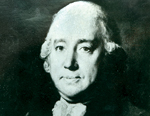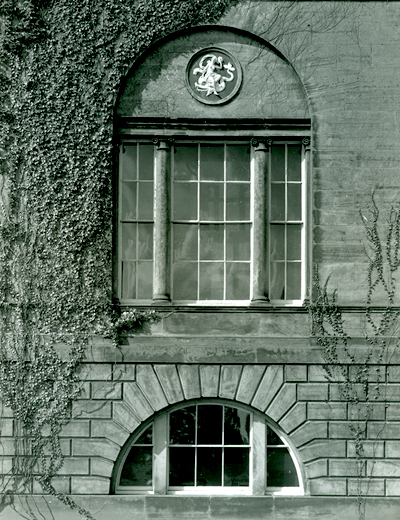Great British Architects: Samuel Wyatt (1737-1807)
Working in the neo-classical manner, Samuel Wyatt was a consistently good architect as well as an accomplished businessman


Although overshadowed by his brilliant younger brother James, Sam-called ‘Chip' in reference to his origins as a carpenter-was hardly less accomplished as an architect and much more efficient as a businessman, making a fortune. He worked in a consistent neo-Classical manner, a development of the early Wyatt style, but more austere. He designed lighthouses, model farm buildings and moderate-sized country houses of distinctive appearance with segmental domed bows.
He was also an engineer, who created the Albion Mills at Blackfriars, with Boulton & Watt engines, the first steam-powered flour mill in the world and with an ingenious brick foundation raft. He experimented in the use of new materials and techniques more than any of his contemporaries, inventing the ‘sympathetic hinge' and taking out a patent for cast-iron construction. Early career
Samuel Wyatt was the third son of Benjamin Wyatt of Blackbrook Farm, Weeford, Staffordshire, and was born on September 8, 1737. He was trained as a carpenter and worked at first for the family building firm, Benjamin Wyatt & Sons, with his older brother William, a surveyor, and his younger Joseph, a mason.
In 1760, he was engaged as a master carpenter and later clerk of works at Kedleston, then the largest building contract in the Midlands. This had a decisive impact on his career, as working for Robert Adam, a leading neo-Classicist, and Lord Scarsdale, an important neo-Classical patron, amounted to an architectural training, as well as practice in large-scale building construction.
When at Kedleston, he married Ann Sherwin, the daughter of Lord Scarsdale's land agent. They had no children, but he adopted the daughter of his elder brother William. In 1768, he also worked at Blithfield and Shugborough, where he met ‘Athenian' Stuart, who may have recommended him to build the Pantheon in Oxford Street, London, which was designed by James Wyatt in 1769, and, as a joint project, led to the establishment of both Wyatts in London.

Independent practice
Samuel was building contractor for a number of James Wyatt's designs in the 1770s, but, thereafter, the brothers pursued completely independent careers. Samuel specialised in medium-sized country houses, of which Doddington in Cheshire (1777) is the finest example, with its smooth ashlar exterior embellished with Coade plaques and elegant interiors with stucco by Joseph Rose.
Sign up for the Country Life Newsletter
Exquisite houses, the beauty of Nature, and how to get the most from your life, straight to your inbox.
Others include Hooton Hall, Hurstmonceux Place and Barons Hill. His spare neo-Classical manner lent itself to utilitarian buildings, and he enjoyed a reputation as a designer of model farm buildings for improving landlords, such as at Holkham, Penrhyn, Sandon, Somerley, Thorndon and other estates.
He was surveyor to Trinity House and designed its headquarters on Tower Hill, one of his finest works. He also built harbour buildings at Ramsgate, and several lighthouses, including Flamborough Head and Dungeness.
In 1799, he was involved in the first abortive scheme for a Thames tunnel. He also experimented with cast-iron construction, and an iron bridge to his design survives in the park at Culford in Suffolk. He was a close friend of many leading figures of the Industrial Revolution, including Matthew Boulton and James Watt in Birmingham, designing houses for both of them.
Samuel always thought of himself as an engineer-architect rather than an artist-architect like James. He became a member of the Society for Promotion of Arts, Manufactures and Commerce and the Society of Civil Engineers, but never exhibited at the RA. He succeeded Robert Adam as Surveyor to Chelsea Hospital, where he repaired the Governor's House, and lived there in the surveyor's official residence, after the burning of Albion Mill House in 1791.
He died at Chelsea of an ‘apoplexy' when he was putting on his boots to visit a building site, on February 8, 1807, at the age of 70. He is buried in the Hospital Cemetery.
* For more Great British Architect stories like this every week, subscribe and save
Country Life is unlike any other magazine: the only glossy weekly on the newsstand and the only magazine that has been guest-edited by HRH The King not once, but twice. It is a celebration of modern rural life and all its diverse joys and pleasures — that was first published in Queen Victoria's Diamond Jubilee year. Our eclectic mixture of witty and informative content — from the most up-to-date property news and commentary and a coveted glimpse inside some of the UK's best houses and gardens, to gardening, the arts and interior design, written by experts in their field — still cannot be found in print or online, anywhere else.
-
 ‘It had the air of an ex-rental, and that’s putting it politely’: How an antique dealer transformed a run-down Georgian house in Chatham Dockyards
‘It had the air of an ex-rental, and that’s putting it politely’: How an antique dealer transformed a run-down Georgian house in Chatham DockyardsAn antique dealer with an eye for colour has rescued an 18th-century house from years of neglect with the help of the team at Mylands.
By Arabella Youens
-
 A home cinema, tasteful interiors and 65 acres of private parkland hidden in an unassuming lodge in Kent
A home cinema, tasteful interiors and 65 acres of private parkland hidden in an unassuming lodge in KentNorth Lodge near Tonbridge may seem relatively simple, but there is a lot more than what meets the eye.
By James Fisher